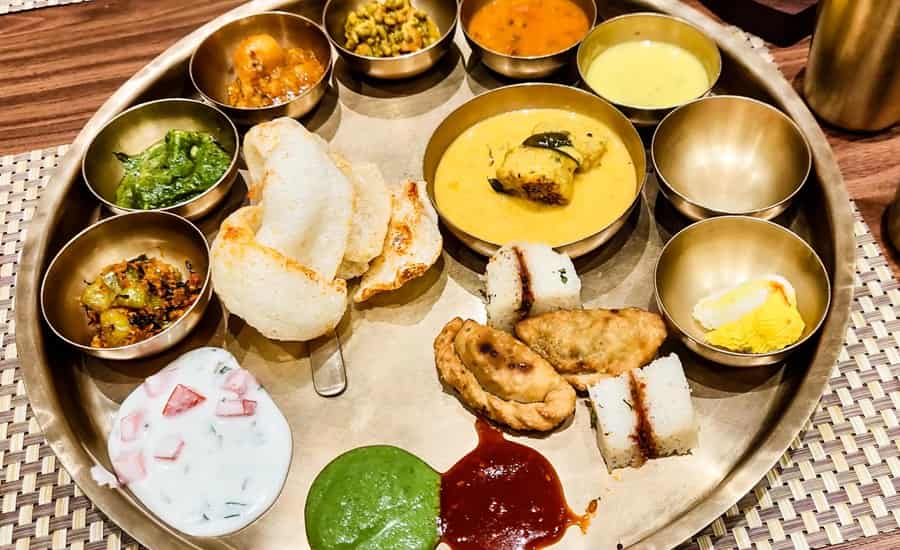Gujarati Thali, a traditional culinary masterpiece from the western state of Gujarat in India, is far more than a mere collection of dishes on a plate. It is a cultural expression, a celebration of flavors, and a testament to the rich culinary heritage of the region. In this exploration, we delve into the intricacies of Gujarati Thali, uncovering its components, cultural significance, and the artistry behind its preparation.

The Essence of Gujarati Thali
At its core, a Gujarati Thali is a meticulously curated assortment of dishes, each contributing to a harmonious and well-balanced meal. The term “Thali” itself, translating to “plate” in Gujarati, goes beyond its literal meaning, embodying a culinary symphony that captures the essence of the region’s diverse flavors.
Historical and Cultural Significance
The roots of Gujarati Thali can be traced back through generations, reflecting the region’s historical, cultural, and agricultural influences. Gujarat’s geographical location, with its coastal areas, fertile plains, and vibrant cities, has played a crucial role in shaping the diverse array of ingredients and culinary techniques found in the Thali.
Components of a Gujarati Thali
A typical Gujarati Thali is an artful composition of various dishes, each carefully chosen to create a balanced and satisfying meal. From the quintessential Roti and steamed Rice to the flavorful Gujarati Dal and a variety of Sabzi (vegetable dishes), the Thali encompasses a spectrum of tastes and textures. The inclusion of Kadhi, Farsan (snacks), Papad, and an assortment of Chutneys and Pickles further adds depth to the culinary experience.
Main Items of a Gujarati Thali
The main items of a Gujarati Thali include:
- Roti or Puri: A type of bread made from wheat flour or semolina.
- Rice: Usually served steamed or as Khichdi, a dish made from rice and lentils.
- Gujarati Dal: A sweet and tangy lentil soup made with pigeon peas.
- Sabzi or Shaak: A variety of vegetable dishes made with seasonal vegetables like potato, brinjal, okra, and fenugreek leaves.
- Kadhi: A spicy yogurt-based soup made with gram flour, curry leaves, and other spices.
- Farsan or Snacks: A variety of fried or steamed snacks such as Dhokla, Khandvi, and Samosas.
- Papad: A thin crispy wafer made from lentil flour.
- Chutneys and Pickles: A variety of tangy and spicy dips made from mint, coriander, tamarind, or mango.
- Sweets or Mithai: Traditional Gujarati desserts such as Shrikhand, a sweet dish made from strained yogurt and flavored with saffron and cardamom.
These items may vary depending on the region and personal preferences, but a Gujarati Thali typically offers a balanced and flavorful combination of sweet, spicy, and sour flavors.
The Symphony of Flavors
Gujarati Thali is a harmonious fusion of sweet, sour, salty, spicy, bitter, and astringent flavors. Each component is thoughtfully crafted to complement others, creating a delightful explosion of tastes that dance on the palate. This symphony of flavors is not just a gustatory experience but a cultural expression, where every dish plays a unique role in the gastronomic ensemble.
Thali as a Cultural Experience
The significance of a Thali goes beyond its gastronomic appeal. It is a cultural experience, embodying the warmth and generosity intrinsic to Gujarati hospitality. The communal aspect of sharing a Thali with family or friends fosters a sense of togetherness, echoing the cultural values deeply ingrained in Gujarati society.
Personal Stories and Connections
For many, the appreciation of Gujarati Thali transcends the culinary realm and becomes a personal journey. Immigrants carry the flavors of Gujarat to distant lands, preserving and sharing their culinary heritage. Personal stories of growing up with Thalis on the family table, adapting to new environments, and rekindling a connection with roots further enrich the tapestry of Gujarati Thali.
Variations and Regional Influences
While the essence of Gujarati Thali remains consistent, variations emerge based on regional influences and personal preferences. The Kathiawadi Thali, for example, introduces regional diversity, showcasing how different communities within Gujarat contribute their unique flavors to the culinary landscape.
Healthful Traditions
Gujarati cuisine, through the Thali tradition, places a strong emphasis on healthful and seasonal eating. The abundant use of fresh produce reflects the farm-to-table concept, where ingredients are chosen based on their availability in different seasons. Nutritional powerhouse ingredients like turmeric and ginger are staples, contributing not only to the flavors but also to the overall well-being of those enjoying the Thali.
Recipes and Mini Thali Ideas
For those eager to recreate the magic of Gujarati Thali in their own kitchens, a variety of recipes await. From Khatta Dhokla and Dhaniya Pudina Chutney to Aloo Baingan Ki Sabzi and Sooji Halwa, the mini Thali ideas showcase the versatility and simplicity of Gujarati cuisine. Each recipe becomes a brushstroke in the vibrant canvas of flavors that define the Thali experience.
Conclusion
In conclusion, the Gujarati Thali is more than a meal; it is a cultural expression, a celebration of fresh produce, and a testimony to the art of balancing flavors. As we traverse the intricate details of each dish, from the rich history to the communal joy it brings, the Gujarati Thali stands as a testament to the culinary mastery embedded in the heart of Gujarat. So, let us embark on this culinary journey, savoring the diverse flavors and traditions that make the Gujarati Thali a true masterpiece on a plate.
Popular Tour Packages
